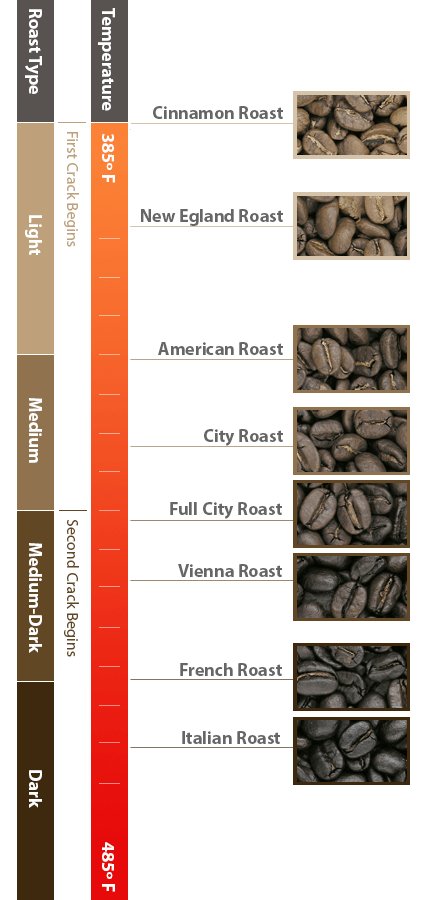Coffee roasting takes a simple, plain green coffee bean and transforms it into a gem bursting with flavor and aroma. Its not magic, this process where coffee gets it “coffee-ness”, but it kind of feels like it. The idea itself is simple, heating the beans to the desired roast level. But its as much an art as a science, and takes great skill to bring out the best in the beans. If you’ve ever wondered just what those roast types mean and where they come from, read on!
Roast Basics
- The roasting process starts with ‘green’ coffee beans, which are very bland to the taste and smell. In other words, the coffee flavor and aroma as we know it develops only as the result of chemical reactions that occur during roasting. The art, and goal, of roasting is to heat the beans in a way that brings out their best flavor.
- The lightest roasts are beans that have reached about 385º F and the darkest roasts do not go over about 485º F.
- When the temperature reaches approximately 385º F, the bean pops as water, oxygen and carbon dioxide escape. There is an audible popping sound and the bean doubles in size. This is know as the ‘First Crack’, and marks the beginning of the light roast phase.
- When the temperature reaches approximately 435º F, it pops again as the structure of the bean starts to collapse. This is know as the ‘Second Crack’, and marks the beginning of the dark roast phase.
The following chart shows four common roast types along with several common roast names that you are likely to come across. The roast names (such as “City Roast”) are used to refer to the level of roast the beans have achieved, and are not related to either the origin or the brand of the beans.

Note: Because coffee roasting is part science and part art, the details vary slightly in real life. Our illustration uses approximations to give you a good overview of the process.
Image credits: Roasted coffee bean images: By Dan Bollinger (Own work) [CC-BY-SA-3.0 (http://creativecommons.org/licenses/by-sa/3.0)], via Wikimedia Commons
Roast Descriptions and Flavors
| Roast Type | Appearance | Flavor | Examples |
| Light Roast | Beans are light brown with no visible oil on the surface. | Retains the most natural flavors from the beans. Often are not well-balanced, so one flavor may be prominent. Note: Lighter roasts have the most acidity, least bitterness and most caffeine. |
Light City Roast Cinnamon Roast Blonde Roast Half City Roast |
| Medium Roast | Beans are medium brown with no visible oil on the surface. | More body and more balance of flavor, aroma, and acidity. The characteristics of the natural flavor are still clear. Traditional American coffee is a medium roast. | Regular Roast American Roast City Roast Breakfast Roast |
| Medium-Dark Roast | Beans are a rich, dark brown with some visible oil on the surface. | Heavier body and begins to take on more taste from the roasting. May be slightly spicy. | Full City Roast After Dinner Roast Vienna Roast |
| Dark Roast | Beans are very dark brown or black, with a shiny, oily surface. | Bitter, smoky or even burnt taste. Original flavors are completely overwhelmed by the roasting process. Note: Darker roasts have the least acidity, most bitterness and least caffeine. |
French Roast Italian Roast Continental Roast Spanish Roast |
A Look Inside the Roasting Process


